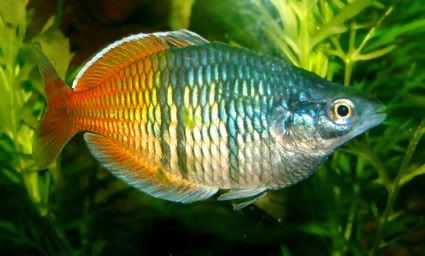FishProfiles.com Message Forums |
| faq | etiquette | register | my account | search | mailbox |
| Bosemani Rainbows | |
ClaireH Fingerling Posts: 32 Kudos: 23 Votes: 0 Registered: 18-Apr-2005   | Hi everyone, I got 4 bosemani rainbows today and made sure that i got the guy to check that I was getting 2 male 2 female. Could anyone tell me what the difference is with juvenile bosemani... im finding it hard to tell which is which after trying to watch them most of the day!! Im not sure if iv been given 2 male 2 female... Thanks Claire |
Jonny Googs Small Fry Posts: 10 Kudos: 4 Votes: 0 Registered: 20-Nov-2005   | Hi Claire, I can't say for sure which is which sex, but my juveniles are slightly different patterned (at least, as far as I can see) - one pattern is the traditional blue at the front, yellow at the back, the other is more greeney, with a highly colourful anal fin. Hope that helps (or is even understandable...) Live it like you love it. |
longhairedgit     Fish Guru Lord of the Beasts Posts: 2502 Kudos: 1778 Votes: 29 Registered: 21-Aug-2005   | The differences are very subtle in juveniles with only the vaguest of patternation and build differences. Its probably quicker to post a piccie than explain how its done, a lot of the talk about lateral bars and stripes and head scalation etc that a lot of rainbow keepers go on about I find inconclusive and hugely variable when applied to juveniles, a lot of which come from different regional populations and have different raising conditions, thusly possibly affecting optimum development of sexual characteristics. Post a piccy and ill sex them for you. This is a typical adult male BTW.  ...and this is an archetypal female, although with selective breeding there are a lot more females showing brighter colouration closer to that of the males. The problem is , of course, that males of less than 6 months of age often look almost identical to this female, hence the difficulty in sexing them.  and if you catch this thread, Entkitty has a nice shot of a young-ish breeding pair in the same picture together, the male is obviously the most vivid, and it might give you a few clues. http://www.fishprofiles.com/files/threads/26754.1.htm?79# |
ClaireH Fingerling Posts: 32 Kudos: 23 Votes: 0 Registered: 18-Apr-2005   | I have noticed some have a dark possibly blue line through the middle of them and I was thinking maybe that would be a clue but it seems to be only on one side of one and both sides of another and 2 dont have it at all. My boyfriend has 4 and they are older so alot more obvious to tell and the males are very easily identified. Unfortunately im not a premium member so I cant post pics. All four have the green tinge to them but as I said 2 have the dark blue line. How long does it take for them to start getting the more obvious colouring? Thanks again  |
longhairedgit     Fish Guru Lord of the Beasts Posts: 2502 Kudos: 1778 Votes: 29 Registered: 21-Aug-2005   | It depends on age, size, sex, diet and happiness, a lot of rainbows get blanched out if they are stressed. They should start to show truly bright aduly colouration after a year to 18 months. Ive bought blanched-out specimens who have coloured up within 2 weeks of getting them home, sometimes even when they are surprisingly young. On the line front, both sexes of juveniles can get those, ive often read about it being an exclusively female characteristic, but since then and having over 100 rainbows at the moment I now know it to be a completely false statement. The strong line is there in both sexes, its just that the patternation is lost by nearly all males eventually, and even some females go to male patternation but remain just slightly duller and less vivid. Females are more likely to retain the stripe to a later age, and that is all. |
| Jump to: |
The views expressed on this page are the implied opinions of their respective authors.
Under no circumstances do the comments on this page represent the opinions of the staff of FishProfiles.com.
FishProfiles.com Forums, version 11.0
Mazeguy Smilies